We’ve put a lot of thought and a lot of work into converting our yard from a conventional landscape to a living landscape. We gradually replaced non-natives with natives and now have more than 95% native plants — and a yard full of life!
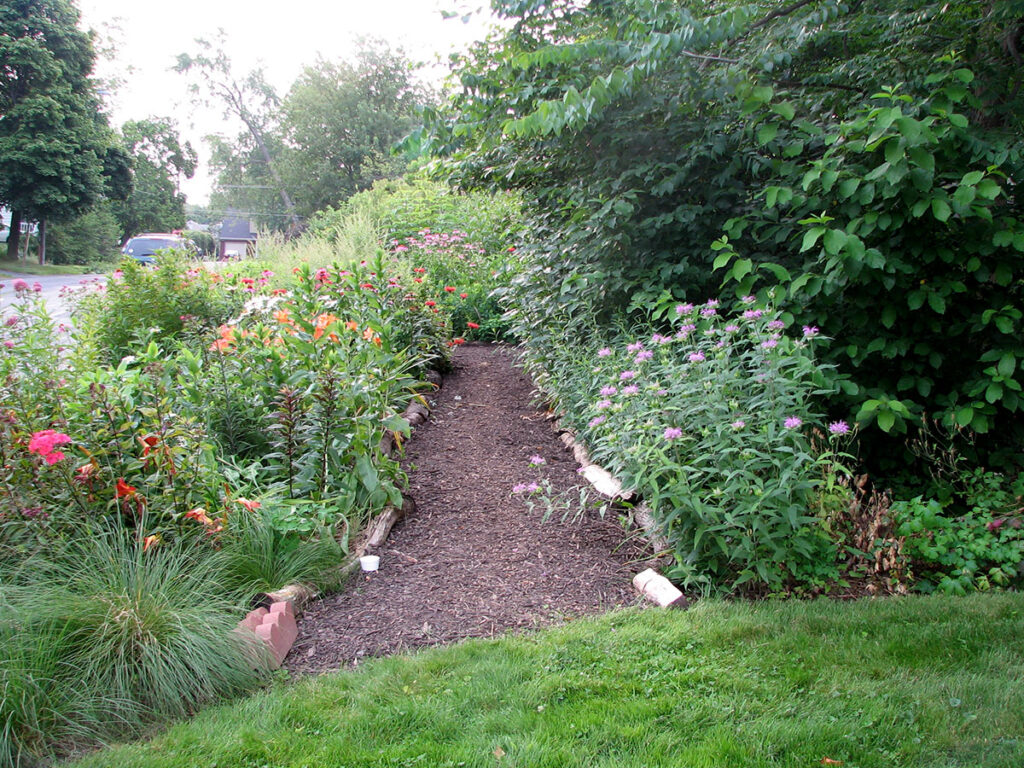
This was especially challenging in the late 1990s here in CNY because there was little information about creating an earth-friendly landscape in our region — and even fewer native plants available. This photo shows that by 2009 some non-natives remained but we had made a lot of progress in the previous ten years.
Now, thankfully, there are many more resources. One thing I wish we had had were Tallamy’s books, and especially The Living Landscape, which has so many photos of living landscapes. It would have helped us visualize our goals and develop a new aesthetic, besides giving lots of practical tips. We muddled through, though, and just by continuing to plant native plants we made a lot of progress.
We didn’t do this all at once. In fact, converting gradually let us learn as we went along, seeing what worked and what didn’t work.
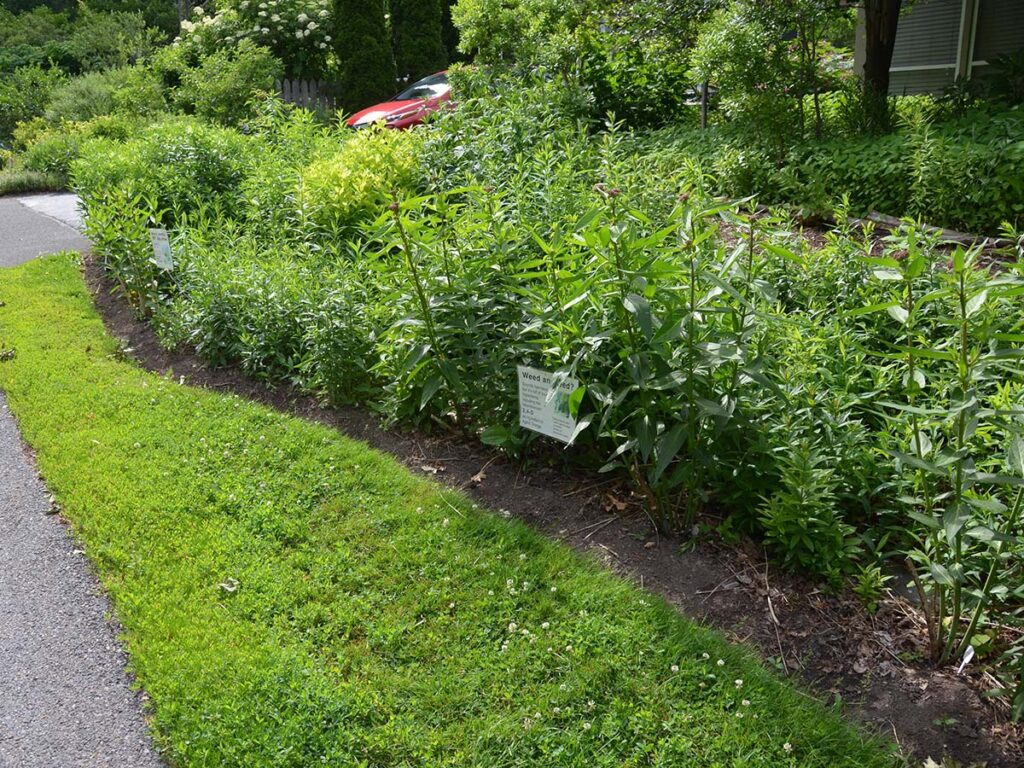
It also helped us learn to appreciate a less manicured aesthetic — different from the sterile “look” we grew up with, the kind that appears on all those real estate ads.
We also learned the magic of having neat borders, lending an orderly look to an otherwise fully planted landscape.
The simplest thing with the most impact
Planting single large trees or groups of smaller trees and shrubs under-planted with ground cover, smaller shrubs, perennials, or even just leaf mulch is very habitat-friendly and doesn’t require much care. These plantings decreased our yard maintenance since they took up space that otherwise would be high-maintenance (and low life-supporting) lawn.
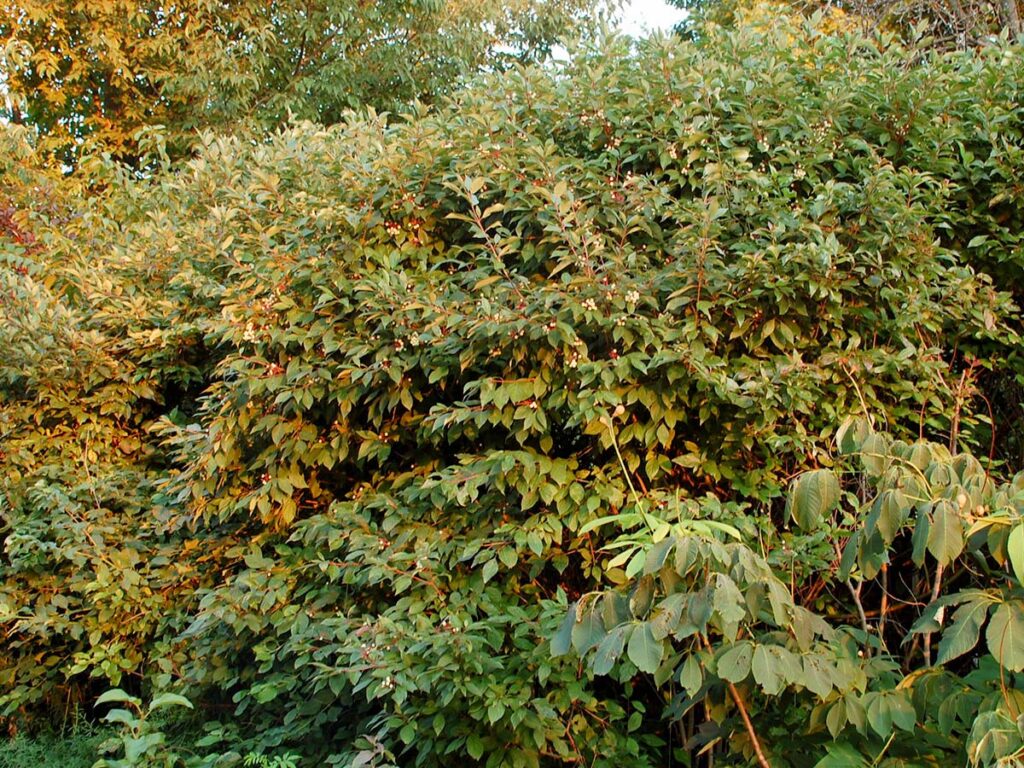
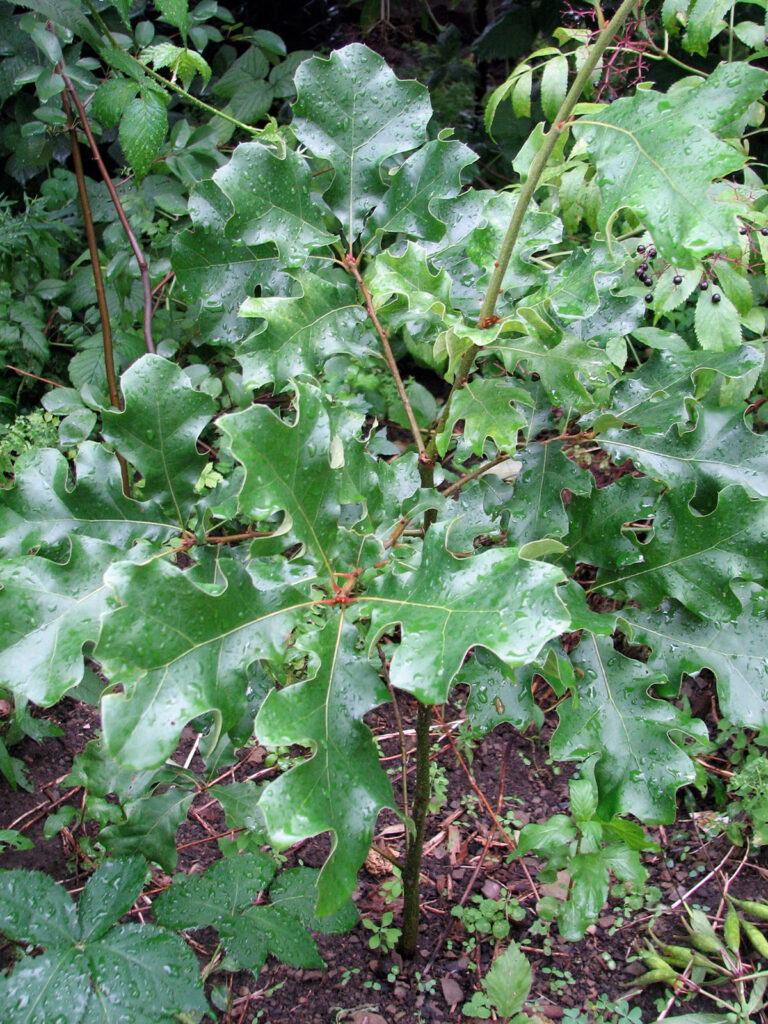
Especially here in the Northeast, a woodland-like landscape is the most beneficial for wildlife and the environment.
And of course, we made those plants NATIVE!
This red oak tree that we planted as a seedling in 2008 is now (2022) about 15 feet tall. At the time we didn’t appreciate how important oaks are, so we were just lucky to have planted one back then.
Our Kentucky coffee tree, on the other hand, though native, doesn’t support nearly as many insects.
Our choice of tree species has more impact than most of our other gardening and landscaping decisions. Just think of it. Canopy trees live a long time — some like oaks even hundreds of years. Our great-great-great grandchildren and beyond could still be enjoying the benefits of the native trees we’ve planted — OR suffering the environmental consequences of non-native invasive ones.
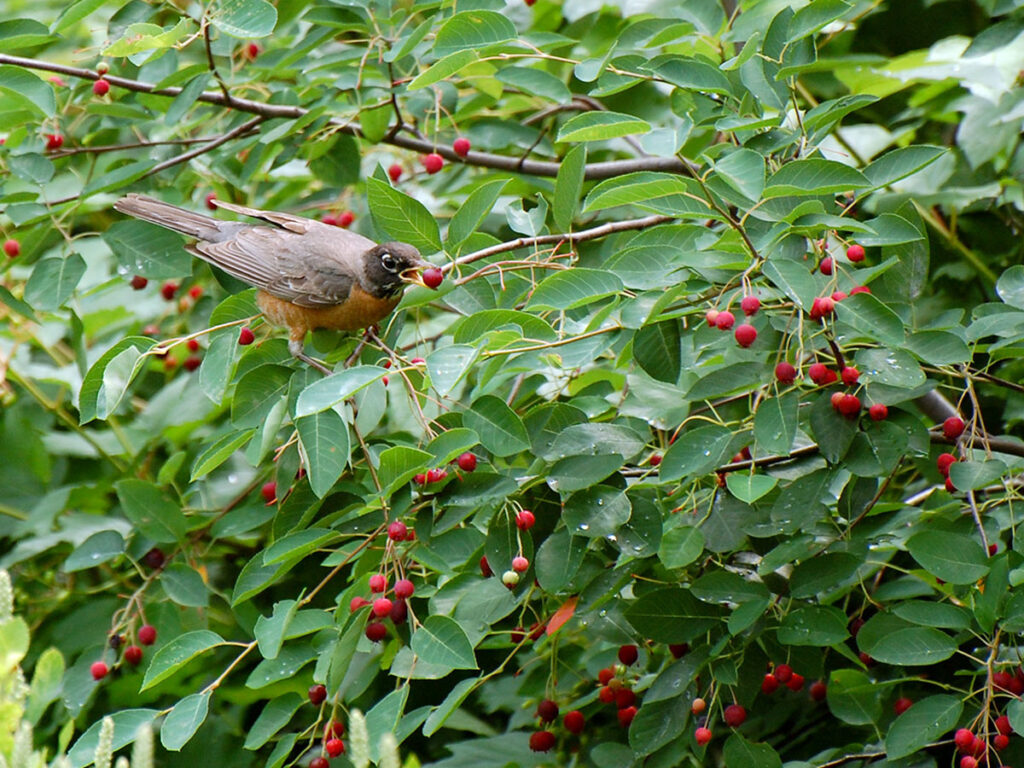
We started thinking of “benefits” differently. Originally, I wanted birds to benefit from the fruits of trees and shrubs and from the seeds created by flowers and grasses. This is indeed a benefit, but with Tallamy’s books, we realized that the most significant benefit is a plant’s ability to feed insects, an important foundation of all life on earth. This is indeed a change from when I was a young ornamental gardener! Back then, insects were the enemy since they “disfigured” leaves, marring their “perfection.” I often think of my grandmother’s saying: “Pretty is as pretty does” (though I’m sure she wasn’t thinking of the benefits of insects eating leaves!)
How we did it. YOU can too!
We made our yard a better place for wildlife and people by doing the following things. You can, too!
1) GO NATIVE: Native plants support biodiversity. Even people with little interest in gardening choose new plants sometimes. When you do, choose native plants, especially trees and shrubs (and native trees and shrubs are easier to care for than ornamental flower gardens anyway). And now in 2022, NWF has published a list of Keystone native plants for our ecoregion. [See the Resources below to get the whole list for your ecoregion.] And ensure that they’re the plain species, not some of the fancy cultivars of natives they’ve created.
2) REMOVE EXISTING NON-NATIVE INVASIVES: One of the first things we did was to get rid of all the invasive plants we (and most other homeowners) had bought and planted: barberries, burning bushes, kousa dogwood etc. etc. etc. We were fortunate that the Labor Day Storm removed the Norway maples for us.
Invasive plants spread to natural areas, changing their character and displacing the native plants our native creatures evolved with. Even if you live in the suburbs and they don’t appear to be spreading in your yard, they spread to natural areas either directly if you live close by or through seeds deposited in bird droppings. Bad for wildlife and bad for people.
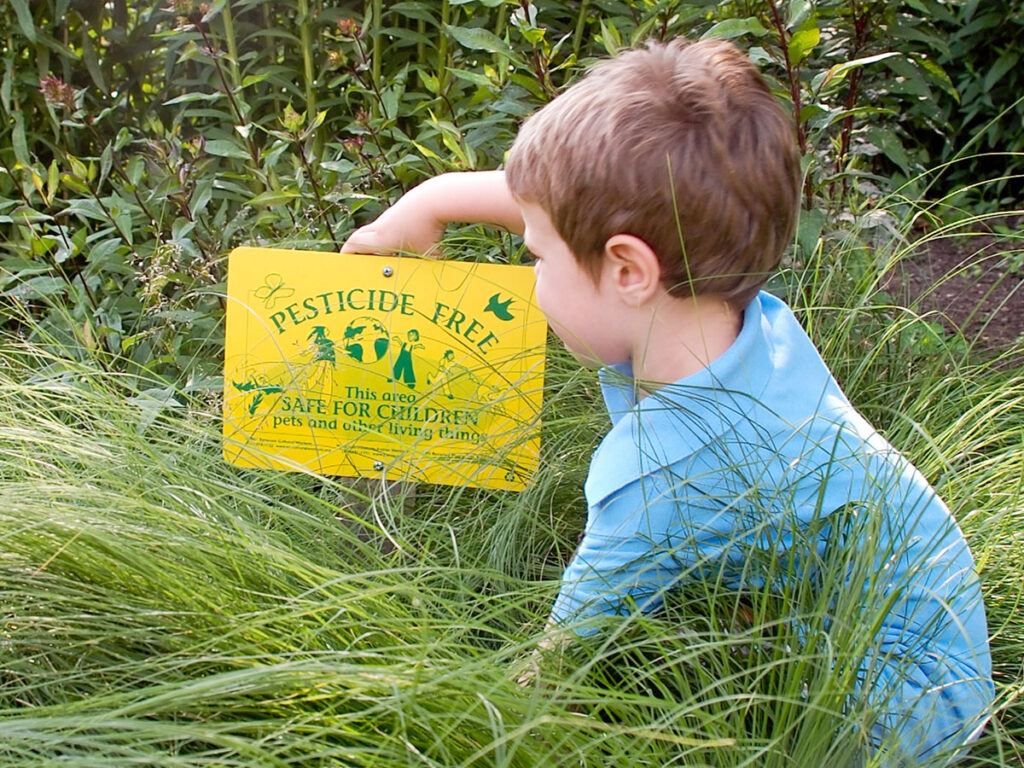
3) ELIMINATE PESTICIDES: Reduce, or preferably eliminate, your use of pesticides, herbicides, and all the other “cide”s. (Remember “cide” is a Latin suffix meaning “kill.”) Accept some less-than-perfect flowers, leaves, and lawn. Is perfection worth risking our health, killing the pollinators that help provide our food, and poisoning our planet? This is especially important for households with kids or pets, or for households next to people with kids or pets, or for households who invite people with kids or pets to their house, or … In other words, for everyone who cares about having a healthy planet now and for future generations.
Going a little farther
You’ll accomplish a lot, as noted above, by choosing native plants, eliminating non-native invasive plants, and not using pesticides.
The next two actions may take a little more effort, but they can make your yard even more habitat-friendly. If you take these actions, you’ve started to create a full-fledged habitat garden.
4) REDUCE YOUR LAWN AREA: “Cut your lawn — in half!” as the National Wildlife Federation says. Lawn has little habitat value. It may be better than blacktop, but it offers no food, shelter, or places to raise young — and it requires water that could better be used for something else. Besides, people in their quest for the perfect lawn often apply harmful pesticides, herbicides, and chemical fertilizers. What’s more, power lawnmowers are even more polluting than cars. You can replace part of the lawn with trees, bushes, other plants, or even just ground cover. Even a native ground cover is better than lawn. Besides, it’s much more interesting to look at, and some have beautiful flowers as a bonus. Use natural lawn care methods to care for the lawn that remains.
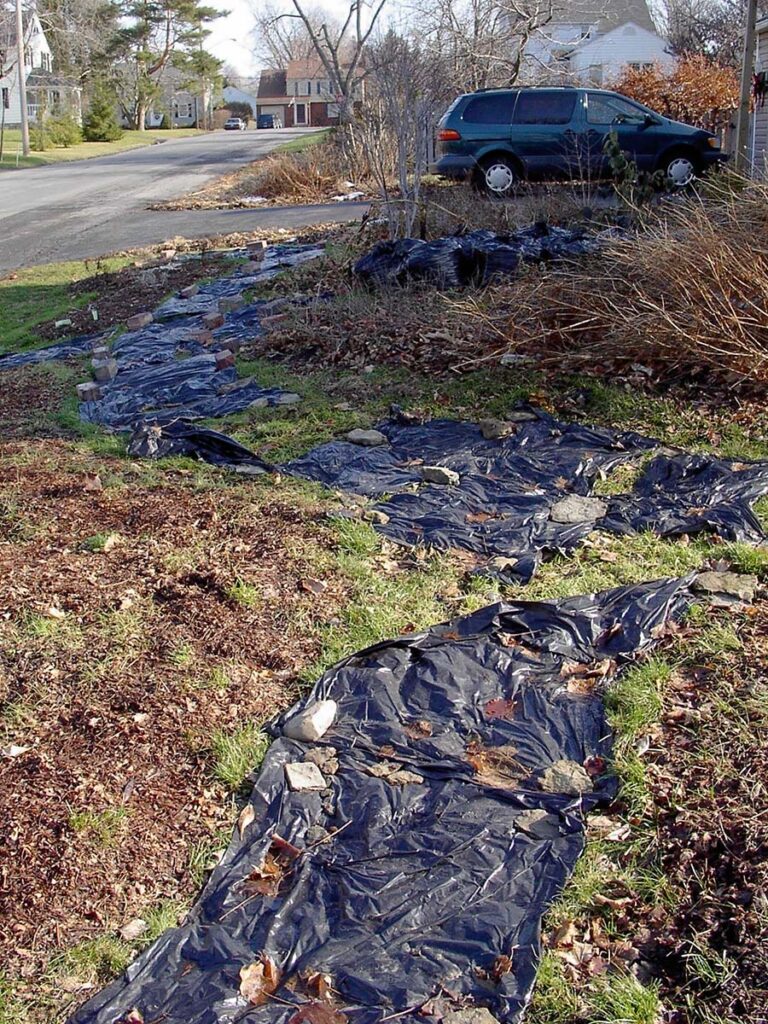
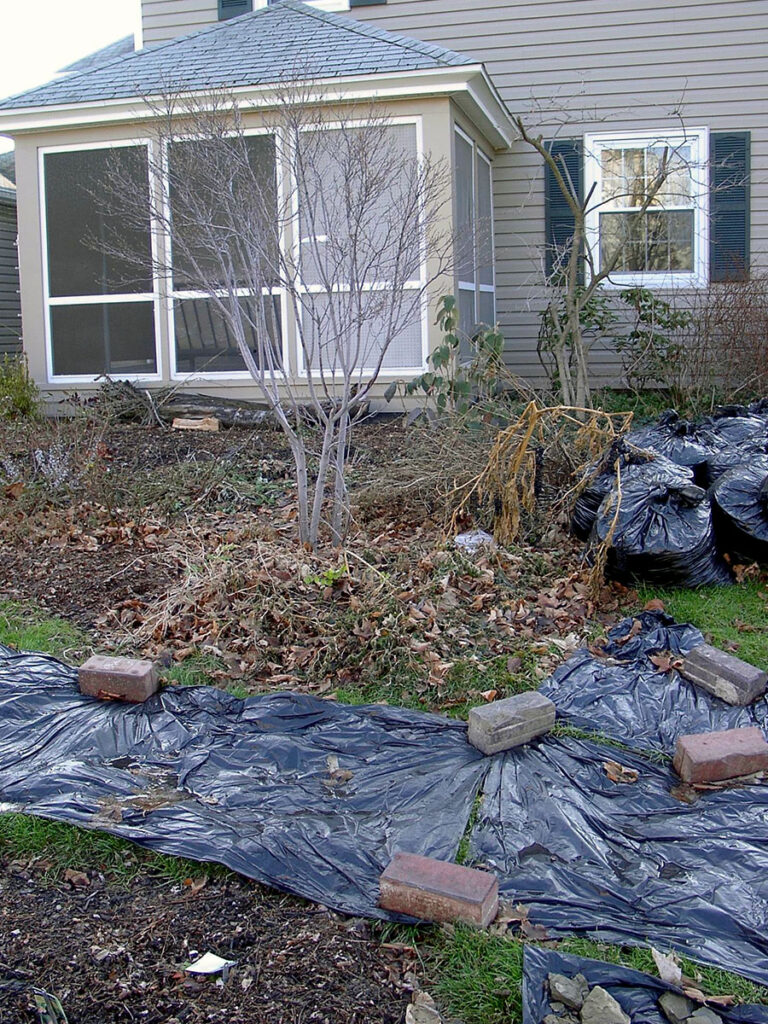
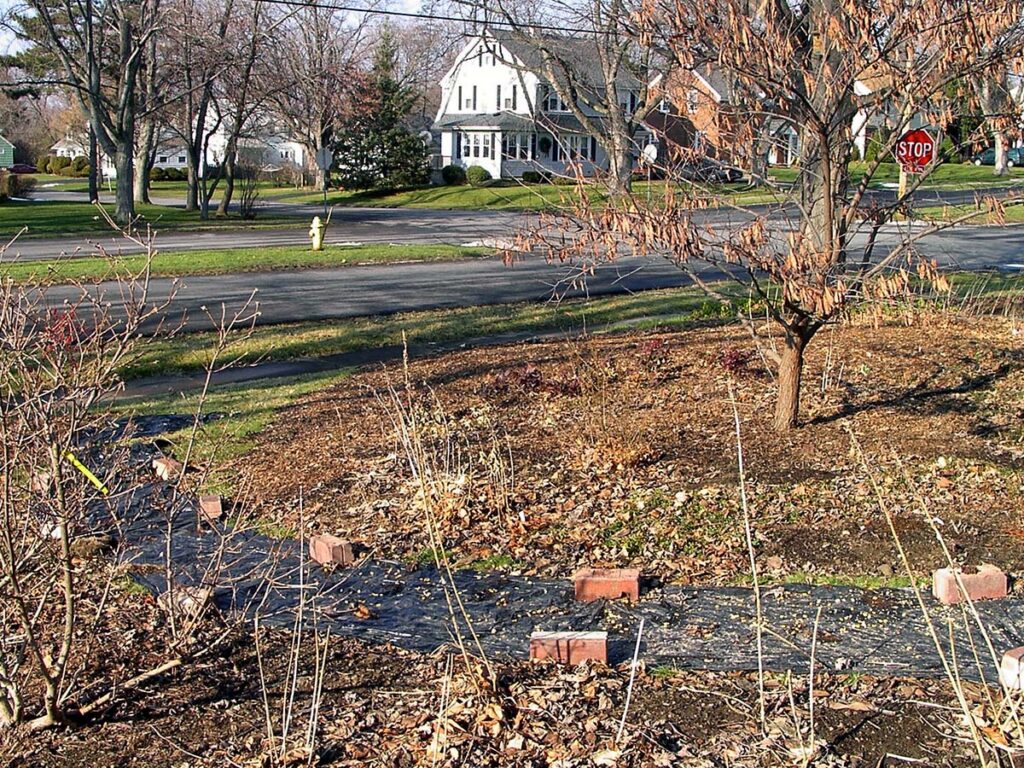
5) BE A LITTLE MESSY: Wherever possible, instead of “neat and tidy,” go for “controlled wildness,” which has much more habitat value. We try to maintain a neat border around the edges. It goes a long way toward making your yard look cared for. We leave the leaves and flower stalks, but at the very minimum, delay fall garden cleanup until the temperatures warm up in the spring, or even better, leave it as a natural mulch and soil builder. There’s a lot of life in that leaf litter!
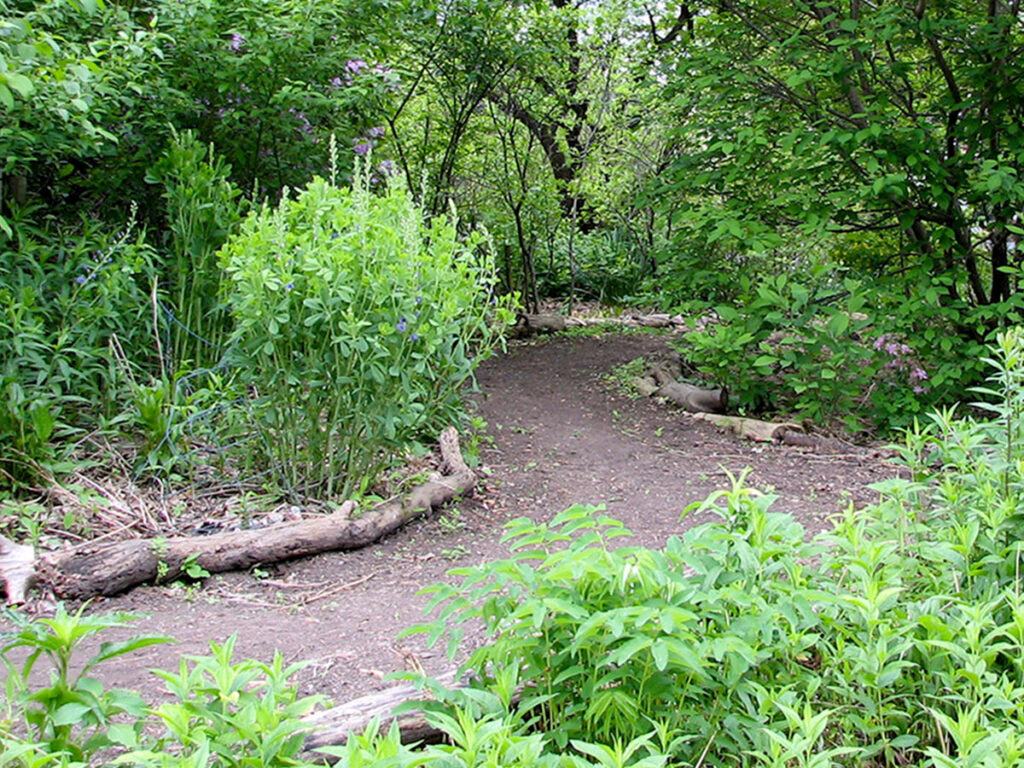
Even while the beds themselves don’t have individual plants in neat lines bordered with mulch, it’s important to keep the border of the beds and the paths neat.
“It must be a lot of work”
This is the first thing people say when they see our yard. Isn’t it funny that they never say that about maintaining a lawn, creating perfectly clipped hedges, or replanting annuals each year? People with conventional landscapes spend hours on these tasks.
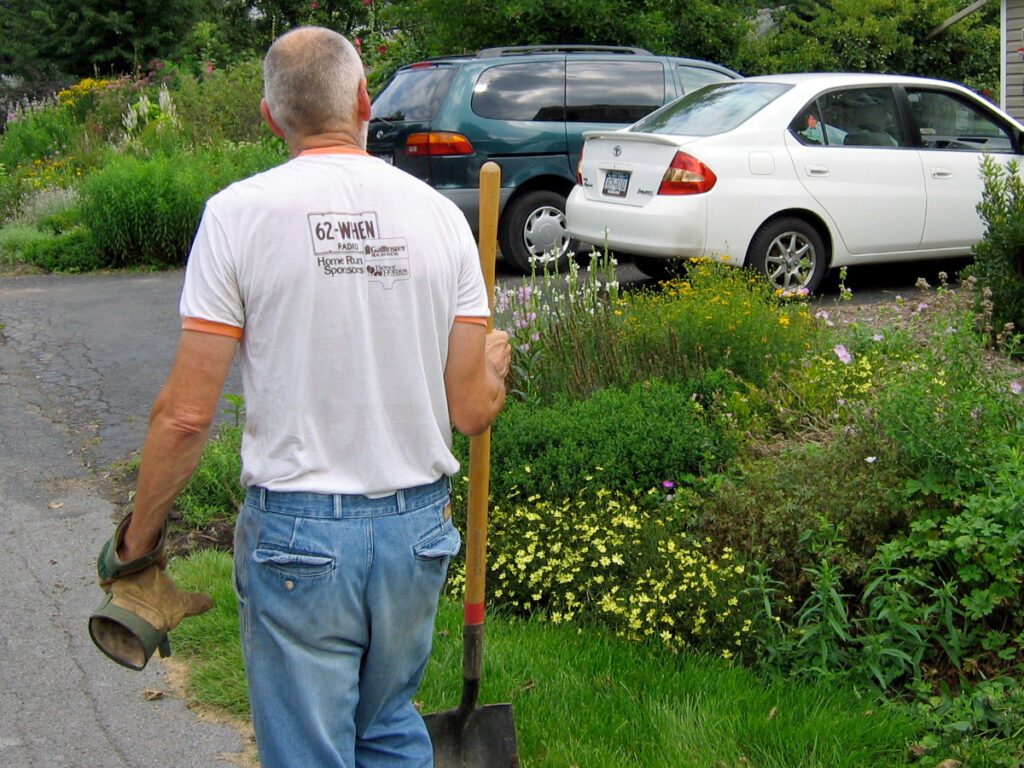
If you think a natural landscape is too much work, it might be because you’re used to thinking of gardening as a series of chores: raking up every dead leaf in the spring; buying and planting annuals each spring and fall; fertilizing, choosing and applying pesticides so each plant is free of imperfections; keeping everything “neat”; ensuring constant bloom; watering frequently; pruning hedges into rigid shapes; and cutting down and disposing of dead plants in the fall.
Gardening becomes just one more thing on an already-overloaded To Do list.
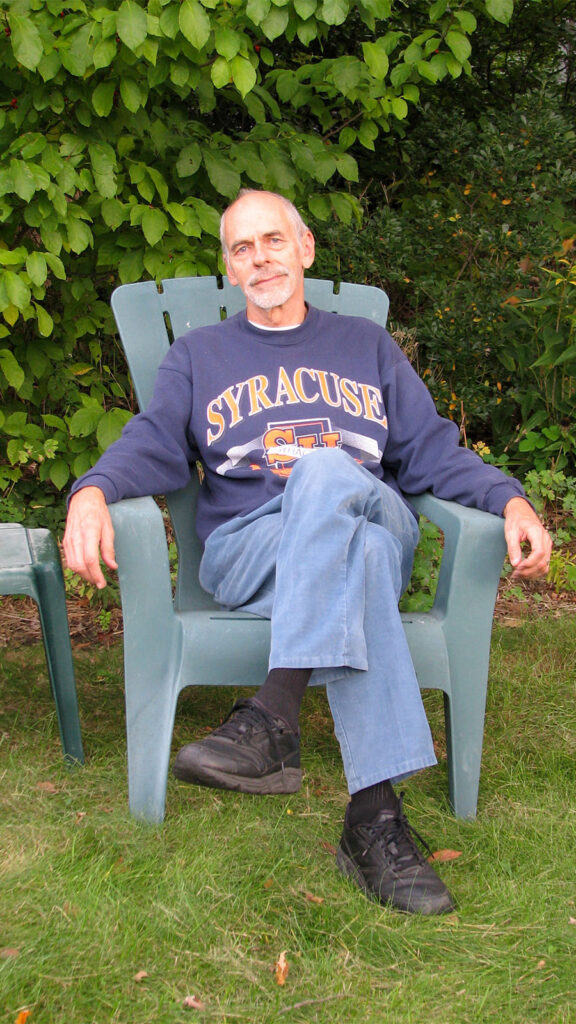
It doesn’t have to be this way. We do very few of these conventional landscaping chores!
We rake leaves only on our mini-lawn area. We don’t fertilize or use pesticides, and we aren’t bothered by a few holes in leaves here or there, especially since they generally represent plants’ contribution to new life.
We accept a little untidiness in planting beds, though we keep the borders neat. We enjoy each plant’s own blooming season, which may be only a month or so, not all summer. We allow shrubs to be their natural shapes (though we’ve had to trim some shrubs whose space requirements we underestimated). We leave plants gone by for the insects and birds over the winter.
Although eliminating most all of our lawn in one season and converting to planting beds was a bit of work, once converted, the overall maintenance isn’t. (And in hindsight, we’d recommend creating a habitat garden in stages anyway.)
We’re not slaves to our yard and if a plant can’t survive pretty much on its own, it just dies out, quickly replaced by volunteers or by another species I want to try. Our biggest task now is “editing” — that is, removing some of the overly enthusiastic plants (such as asters!!) that tend to crowd out others.
Our generation’s job!
The bottom line: Converting our sterile ornamental landscapes into life-supporting land is our generation’s job! The next generations living on our lands will only have to maintain what we’ve returned to an ecologically healthy state.
Want to have a habitat garden but you don’t own land?
There’s a concept called Yard Sharing where people who have land let people who don’t have land use their yard, either to share in the produce or just to enjoy having a habitat garden.
Generally this is done with edible gardening but there’s no reason it wouldn’t work for habitat gardening, too. Imagine an older person or very busy person who just doesn’t have the time or ability to have a garden teaming up with someone who dearly would like to garden but doesn’t own a house or yard. You can learn more about this idea in the Resources section below, BUT it’s probably best to proceed informally and just find someone nearby who fits the bill!
Resources
- Homegrown National Park:
- 10 things to get you started by Doug Tallamy
- Doug’s 5 easy steps for beginners
- What insects and plants – Prioritize!
- National Wildlife Federation:
- BOOK:
- The Living Landscape by Rick Darke and Doug Tallamy has EXCELLENT appendices listing the most useful plants for every region of the country. (And the rest of the book is highly recommended, too!)
- Wild Seed Project:
- VIDEO: Rewilding a landscape – how one family rewilded their yard in Maine
- Ecological Landscape Alliance:
- The Humane Gardener:
- Small garden, big heart – You can do a lot in a small space!
- Wild by design – Make it appealing to people, too!
- Let plants choose their destinies
- Yale Environment 360:
- Monarch Joint Venture:
- Creating pollinator habitat – a guide from MJV
- New Hope Audubon NC:
- Ann Arbor News:
- Creating a pollinator garden for bees and butterflies is a good way to start!
- PennState Extension: Planting pollinator-friendly gardens
- U.S. Fish and Wildlife Service: How to build a pollinator garden
- Tufts Pollinator Initiative: Four ways your garden can support more pollinators – some principles and a “Plant this, not that” kind of list – can be used as a handout
- Kim Eierman of EcoBeneficial: The Pollinator Victory Garden book
- Jessecology:
- PerfectEarth – Gardinista:
- Virginia Native Plant Society:
- ReScape / BayFriendly:
- Virginia DWR:
- Plant layers for habitat structure – most of the plants mentioned are also native to CNY, but the “layers” principle is the same almost everywhere
And if you don’t have your own land …
… find someone who has land but not the time/interest/ability to make the most of it! Most of the following resources discuss sharing yards for vegetable-growing (a worthy endeavor in itself), but you could grow habitat, too!
- Growing a Greener World:
- VIDEO: Locavores and yard sharing – for vegetable gardening/farming
- Humane Gardener:
- Natural Life Magazine:
- Shared Earth:
- Living Homegrown:
- Homegrown National Park:
Reflections
It’s not about what it is, it’s about what it can become.
~ Dr. Suess, The Lorax
You get used to the overall look of a wild garden, which is very different from a manicured garden. If something does die, you don’t mourn it — there’s not a great big hole left because there’s so much richness, so much variety, so much more life overall.
~ Sara Stein, Noah’s Garden
In response to Charles Mann, author of the book 1493, who noted that it’s difficult to restore ecosystems to their natural prehuman state because humans have been manipulating ecosystems for thousands of years:
Charles Mann is absolutely correct. It is very difficult to decide what a natural state is. But it is not difficult at all to know what a productive state is. A productive ecosystem maintains its inherent diversity and produces lots of ecosystem services. Our goal is not to turn the clock back to a particular period and re-create ecosystems that once flourished in North America; we have already changed too many ecosystems components — from soils, to plant communities, to natural fire regimes, to top predators — for this to be possible. Instead, our goal is to restore as much ecosystem productivity as possible by reassembling the specialized relationships that encourage productivity, even if they are not exactly the same relationships that existed at a particular place 1000 or 2000 years ago.
~ Doug Tallamy, FAQ Homegrown National Park
Here’s a secret not all gardeners know — if you choose to be a messy gardener in the fall and winter, the wildlife value of your garden soars.
~ Becca Rodomsky-Bish, Cornell Lab of Ornithology
Ecology isn’t rocket science; it’s much more difficult.
~ Steve Carpenter, Univ. of Wisconsin
A man is ethical only when life, as such, is sacred to him, that of plants and animals as that of his fellow men, and when he devotes himself helpfully to all life that is in need of help.
~ Albert Schweitzer, Out of My Life and Thought, An Autobiography (1933)
We stand at a critical moment in Earth’s history, a time when humanity must choose its future. As the world becomes increasingly interdependent and fragile, the future at once holds great peril and great promise … It is imperative that we, the peoples of Earth, declare our responsibility to one another, to the greater community of life, and to future generations.
~ The Earth Charter
